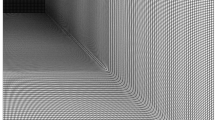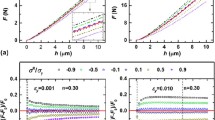Abstract
Instrumented indentation testing is widely used for the mechanical characterization of materials and phases. Among important mechanical parameters such as hardness and Young’s modulus the determination of yield stress and hardening behavior of metallic materials calculated from indentation results is a particular topical subject. This paper presents a methodology which allows for the reconstruction of the stress-strain curve from a single load-displacement curve measured by a spherical indenter. The method is based on the depth-dependent strain field induced by a spherical indenter. The loading part of the curve is discretised in single tuples of indentation depth and force. Since the mean strain induced by the spherical indenter is dependent on indentation depth, every depth can be assigned to a mean uniaxial strain value. The force is then used to calculate the associated uniaxial stress. The method was exemplarily applied to the carbon steel C45 in different heat treatment conditions. It could be shown that after a calibration procedure the stress-strain curves of the carbon steel can be calculated without the requirement of assuming a mathematical description of the curve (e.g. power-law material behavior). The method and its framework can easily be expanded and adjusted in order to be used as an easy and quick method for inverse determination of material parameters.













Similar content being viewed by others
References
Oliver W-C, Pharr G-M (1992) An improved technique for determination hardness and elastic-modulus using load and displacement. J Mater Res 7:1564–1583
Taljat B, Zacharia T, Kosel F (1998) New analytical procedure to determine stress-strain curve from spherical indentation data. Int J Solids Struct 35:4411–4426
Huber N, Tsakmakis C (1999) Determination of constitutive properties from spherical indentation data using neural networks. Part ii: plasticity with nonlinear isotropic and kinematic hardening. J Mech Phys Solids 47:1589–1607
Huber N, Tsakmakis C (1999) Determination of constitutive properties from spherical indentation data using neural networks. Part I: the case of pure kinematic hardening in plasticity laws. J Mech Phys Solids 47:1569–1588
Cao Y -P, Lu J (2004) A new method to extract the plastic properties of metal materials from an instrumented indentation loading curve. Acta Mater 52:4023–4032
Beghini M, Bertini L, Fontanari V (2006) Evaluation of the stress-strain curve of metallic materials by spherical indentation. Int J Solids Struct 43:2411–2459
Collin J -M, Mauvoisin G, Pilvin P (2010) Materials characterization by instrumented indentation using two different approaches. Mater Des 31:636–640
Hasanov A, Muradoglu Z (2012) Fast inversion algorithm for identification of elastoplastic properties of power hardening materials. Int J Non-Linear Mech 47:526–536
Patel D -K, Kalidindi S-R (2016) Correlation of spherical nanoindentation stress-strain curves to simple compression stress-strain curves for elastic plastic isotropic materials using finite element models. Acta Materialia 112:295–302
Chen W -C, Li M, Zhang T, Cheng Y -T, Cheng C -M (2007) Influence of indenter tip roundness behavior in nanoindentation. Mater Sci Eng A 445-446:323–327
Liu L, Ogasawara N, Chiba N, Chen X (2009) Can indentation technique measure unique elastoplastic properties?. J Mater Res 24:784–800
Tabor D (1948) A simple theory of static and dynamic hardness. Proc R Soc London Series Math Phys Sci 192:247–274
Tabor D (2000) The hardness of metals. Oxford University Press, Oxford
Cao Y -P, Qian X, Huber H (2007) Spherical indentation into elastoplastic materials: Indentation-response based definition of the representative strain. Mater Sci Eng A 454-455:1–13
Donohue B -R, Ambrus A, Kalidindi S-R (2012) Critical evaluation of the indentation data analyses methods for the extraction of isotropic uniaxial mechanical properties using finite element models. Acta Metallurgica 60:3943–3952
Pöhl F, Huth S, Theisen W (2014) Indentation of self-similar indenters: An FEM-assisted energy-based analysis. J Mech Phys Solids 66:32–41
Field J -S, Swain M -V (1993) A simple predictive model for spherical indentation. J Mater Res 8:297–306
Lee J -H, Kim T, Lee H (2010) A study on robust indentation techniques to evaluate elastic-plastic properties of metals. Int J Solids Struct 47:647–664
Ahn J -H, Kwon D (2001) Derivation of plastic stress-strain relationship from ball indentations. J Mater Res 16:3170–3178
N’Jock M -Y, Chicot D, Decoopman X, Lesage J, Ndjaka J -M, Pertuz A (2013) Mechanical tensile properties by spherical macroindentation using an indentation strain-hardening. Int J Mech Sci 75:257–264
Swaddiwudhipong S, Tho K -K, Liu Z -S, Zeng K (2005) Material characterization based on dual indenters. Int J Solids Struct 42:69–83
Pharr G -M, Herbert E -G, Gao Y (2010) The indentation size effect: A critical examination of experimental observations and mechanistic interpretations. Annu Rev Mater Res 40:271–292
Swadener J G, George E -P, Pharr G -M (2002) The correlation of indentation size effect measured with indenters of various shapes. J Mech Phys Solids 50:681–694
Qu S, Huang Y, Pharr G -M, Hwang K -C (2006) The indentation size effect in the spherical indentation of iridium: A study via the conventional theory of mechanism-based strain gradient plasticity. Int J Plast 22:1265–1286
Niederhofer P, Pöhl F, Geenen K, Huth S, Theisen W (2016) Influence of crystallographic orientation on cavitation erosion resistance of high interstitial CrMnCN austenitic stainless steels. Tribol Int 95:66–75
Author information
Authors and Affiliations
Corresponding author
Appendix: Equation
Appendix: Equation
Rights and permissions
About this article
Cite this article
Pöhl, F. A Methodology for Inverse Determination of Stress-strain Curves Based on Spherical Indentation. Exp Tech 42, 343–353 (2018). https://doi.org/10.1007/s40799-018-0238-1
Received:
Accepted:
Published:
Issue Date:
DOI: https://doi.org/10.1007/s40799-018-0238-1




